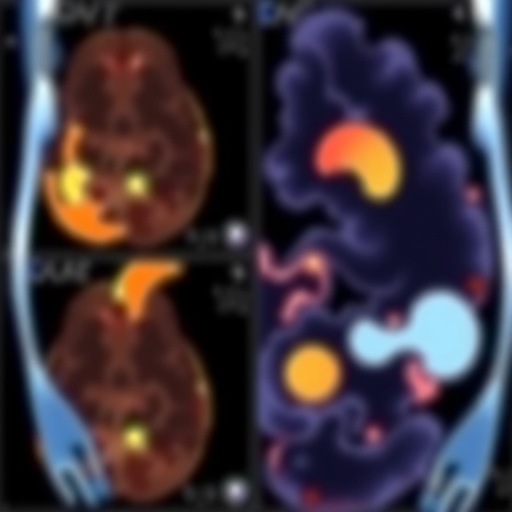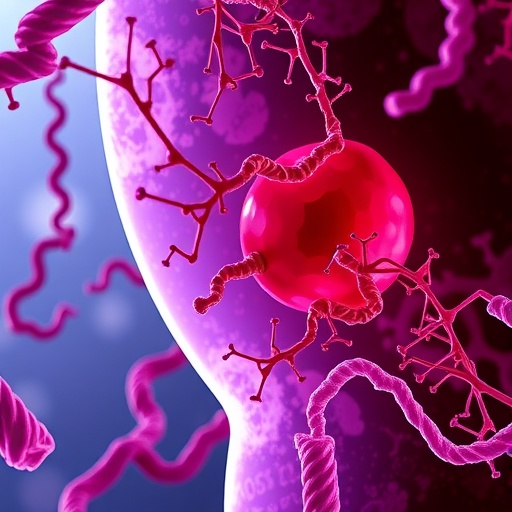In a groundbreaking development that could redefine cancer therapy, researchers have unveiled a novel approach to delivering topoisomerase I (top1) inhibitors directly to tumors while simultaneously optimizing poly (ADP-ribose) polymerase (PARP) inhibition. This dual-targeted strategy was rigorously examined in a recent phase I clinical trial, demonstrating promising potential to transform the treatment landscape for patients with advanced solid tumors. The approach, which employs “gapped scheduling,” presents a sophisticated evolution in drug administration designed to maximize therapeutic efficacy while minimizing systemic toxicity—a perennial challenge in oncology.
Topoisomerase I inhibitors have long been pivotal in oncology due to their ability to interfere with DNA replication by stabilizing the enzyme-DNA cleavage complex, ultimately triggering lethal DNA breaks in rapidly dividing cancer cells. However, their clinical utility has been hampered by dose-limiting toxicities and resistance mechanisms. Similarly, PARP inhibitors have garnered attention for their ability to exploit synthetic lethality in tumors deficient in DNA repair mechanisms, such as BRCA mutations. Yet, combining these inhibitors effectively and safely has been elusive due to overlapping toxicities and pharmacodynamic complexities.
The innovation showcased in the recent trial involves a tumor-targeted delivery system for top1 inhibitors that enhances drug accumulation precisely where it is needed most—the tumor microenvironment. This targeting not only amplifies the destruction of malignant cells but also spares healthy tissue, reducing collateral damage. Meanwhile, the optimized PARP inhibition schedule interspersed within this treatment regimen—referred to conceptually as “gapped scheduling”—represents a carefully choreographed administration plan that capitalizes on non-overlapping drug activity windows and DNA damage response dynamics.
Conducted by a team led by Thomas et al., the phase I trial enrolled patients with a variety of advanced solid tumors refractory to standard treatments. The trial’s design was meticulous, emphasizing safety, pharmacokinetics, and preliminary efficacy signals. Patients received administration of the tumor-directed top1 inhibitor with PARP inhibitor dosing strategically spaced to harness synergistic effects while avoiding cumulative toxicities commonly observed in concurrent regimens.
Early clinical data from the trial are compelling. Several patients exhibited significant tumor regression, including partial and complete responses in some cases, with manageable side effects indicative of an improved therapeutic index. Notably, the pharmacokinetic profiles showed sustained drug presence within tumor tissues compared to plasma, verifying the precision targeting mechanism. Importantly, common adverse events such as myelosuppression and gastrointestinal toxicity were less pronounced than historical controls, underscoring the potential clinical advantage of gapped scheduling.
The molecular rationale underpinning this approach derives from a nuanced understanding of DNA damage repair pathways and cell cycle regulation. Top1 inhibitors induce DNA single-strand breaks during replication, which, if unresolved, convert to double-strand breaks. PARP enzymes are intricately involved in repairing such single-strand breaks, thereby presenting an ideal secondary target to prevent tumor cell recovery. By temporally separating inhibitor administration, the “gapped” design mitigates overlapping toxicities while still achieving cumulative DNA damage sufficient to trigger cancer cell death.
Technological advancements in drug delivery vehicles contributed significantly to these outcomes. Nanoparticle formulations and conjugate chemistries were optimized to facilitate selective tumor uptake via enhanced permeability and retention effects, as well as active targeting ligands recognizing tumor-specific biomarkers. This precision delivery curtails systemic exposure, sparing organ systems that often bear the brunt of chemotherapy-related toxicities.
Beyond pharmacodynamics, this study also sheds new light on the importance of treatment scheduling in combination therapies. Whereas concurrent dosing regimens often face logistical and biological constraints, the introduction of deliberate dosing gaps holds promise for expanding the therapeutic window. This paradigm shift suggests that temporal modulation of drug exposure—which considers tumor cell cycle phases, repair kinetics, and drug clearance—can maximize anti-cancer activity while attenuating adverse reactions.
The implications of this research are profound, particularly for cancers with limited treatment options or those resistant to conventional chemotherapy. By orchestrating DNA damage and repair blockade in a spatially and temporally refined manner, this gapped scheduling strategy may open avenues for personalized treatment plans grounded in tumor biology and pharmacological principles.
Future research directions include expanding this approach to other tumor types and combining it with immunotherapy modalities. The interplay between DNA damage-induced immunogenic cell death and immune checkpoint inhibition represents an exciting frontier, where synergistic enhancements could yield durable control over aggressive malignancies. Additionally, biomarker development to identify likely responders will be key to translating these findings into routine clinical practice.
In summary, the phase I trial led by Thomas and colleagues marks a milestone in the journey toward more effective, targeted, and tolerable cancer treatments. Their innovative use of tumor-targeted top1 inhibitors alongside optimized, gapped PARP inhibition underscores the critical role of strategic drug delivery and scheduling in overcoming long-standing barriers in cancer therapy. While further investigation is warranted, this pioneering strategy could profoundly influence therapeutic paradigms, promising new hope for patients battling advanced solid tumors.
As this research continues to gain momentum, it invites a reimagining of how anticancer combinations are conceptualized, designed, and implemented. The recognition that “when” a drug is given can be as vital as “what” drug is given challenges prevailing treatment dogmas and paves the way for highly refined, patient-specific therapies. In a field hungry for innovation, the elegance and efficacy of this tumor-targeted, gapped dosing protocol stand out as a beacon of progress.
Ultimately, these findings add a vital piece to the complex puzzle of cancer treatment, reinforcing the necessity of integrating cutting-edge molecular insights with clinical design innovation. With cancer remaining a formidable global health challenge, approaches like those pioneered by Thomas et al. provide a powerful blueprint for combining precision medicine with biological timing for enhanced patient outcomes.
Subject of Research: Tumor-targeted delivery of topoisomerase I inhibitors combined with optimized PARP inhibition schedules in advanced solid tumors.
Article Title: Tumor-targeted top1 inhibitor delivery with optimized parp inhibition in advanced solid tumors: a phase i trial of gapped scheduling.
Article References:
Thomas, A., Takahashi, N., Oplustil O’Connor, L. et al. Tumor-targeted top1 inhibitor delivery with optimized parp inhibition in advanced solid tumors: a phase i trial of gapped scheduling. Nat Commun 16, 9457 (2025). https://doi.org/10.1038/s41467-025-64509-5
Image Credits: AI Generated
Tags: advanced solid tumors treatmentdrug administration strategiesdual-targeted cancer treatmentgapped scheduling in oncologyminimizing systemic toxicityoptimized tumor therapyovercoming drug resistance in cancer therapyPARP inhibitorsphase I clinical trialsynthetic lethality in cancertopoisomerase I inhibitorstumor microenvironment targeting





